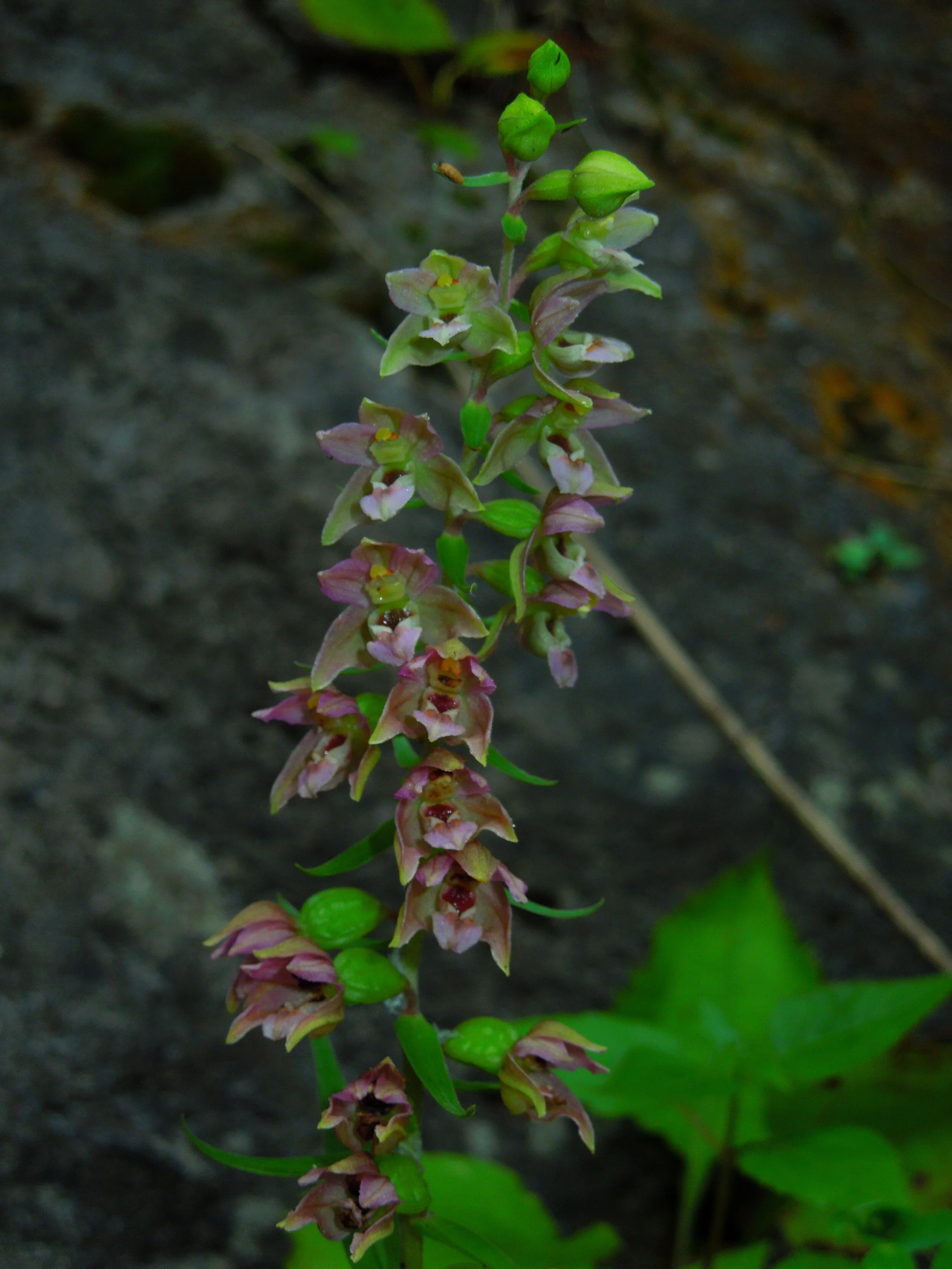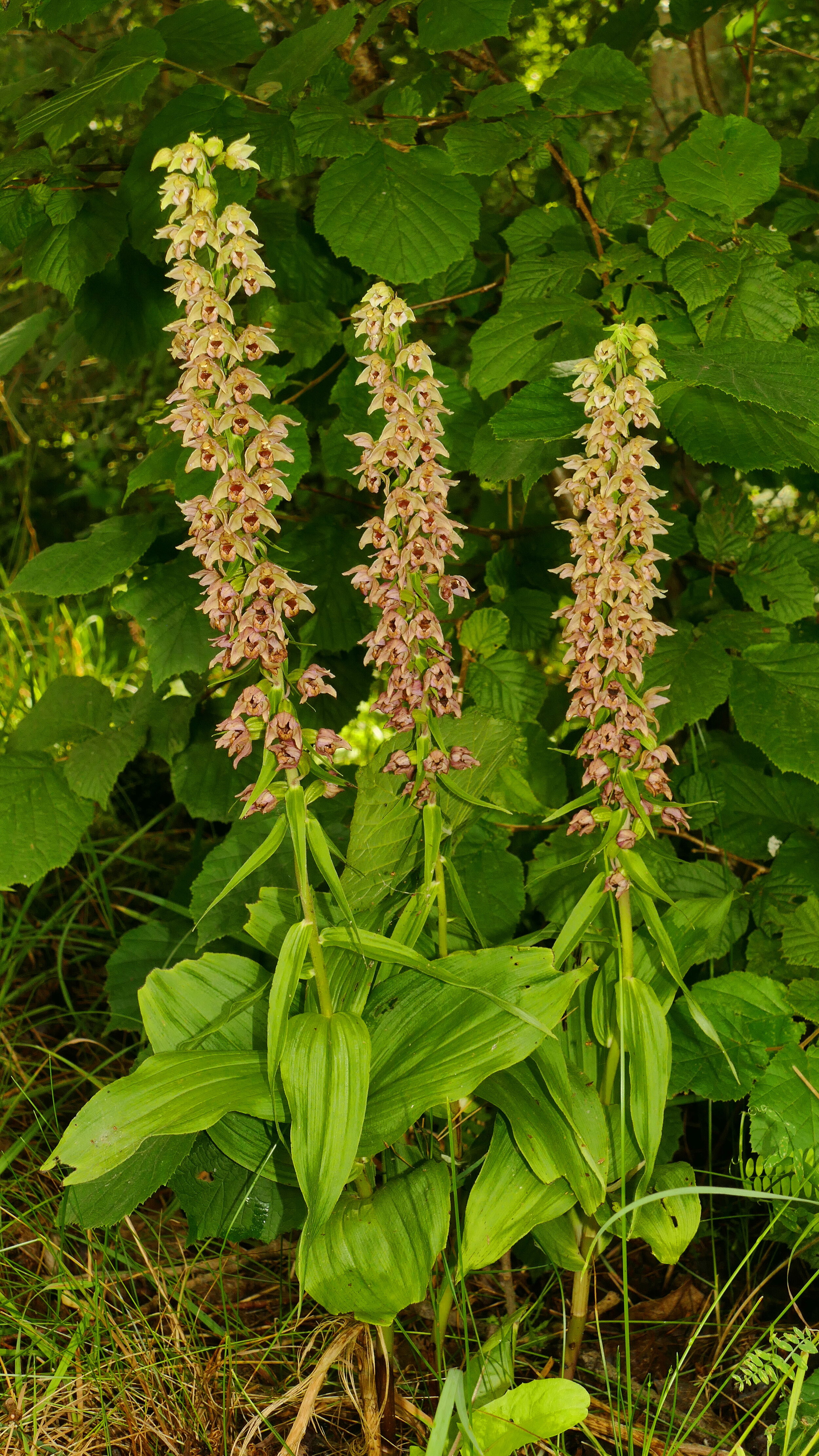There was a time when I thought that all orchids were finicky botanical jewels, destined to perish at the slightest disturbance. Certainly many species fit this description to some degree, but more often these days I am appreciating the role disturbance can play in maintaining many orchid populations. Seeing various genera like Platanthera or Goodyera thriving along trails and old dirt roads, lawn orchids (Zeuxine strateumatica) growing in manicured lawns, or even various Pleurothallids growing on water pipes in the mountains of Panama has opened my eyes to the diversity of ecological strategies this massive family of flowering plants employs.
Of the examples mentioned above, none can hold a candle to the hardiness of the broad-leaved helleborine orchid (Epipactis helleborine) when it comes to thriving in disturbed habitats. Originally native throughout much of Europe, North Africa, and Asia, this strangely beautiful orchid can now be found growing throughout many temperate and sub-tropical regions of the world. Indeed, this is one species of orchid that has greatly benefited from human disturbance. In fact, I more often see this orchid growing in and around cities and along roadsides than I do in natural settings (not to say it isn’t there too). In many areas here in North America, the broad-leaved helleborine orchid has gone from a naturalized oddity into a full blown invasive.
Much of its success in conquering new and often highly disturbed territory has to do with its relationship with mycorrhizal fungi. Like all orchids, the broad-leaved helleborine orchid requires fungi for germination and growth, relying on the symbiotic relationship into maturity. Without mycorrhizal fungi, these orchids could not survive. However, while many orchids seem to be picky about the fungi they will partner with, the broad-leaved helleborine is something of a generalist in this regard. At least one study in Europe was able to demonstrate that over 60 distinct groups of mycorrhizal fungi were able to partner with this orchid. By opening itself up to a wider variety of fungal partners, the broad-leaved helleborine orchid is able to live in places where pickier orchids cannot.
Another key to this orchids success has to do with its pollination strategy. Here again we see that being a generalist comes with serious advantages. Though wasps are thought to be the most effective pollinators, myriad other insects from various kinds of flies to beetles and butterflies will visit these blooms. How is it that this orchid has become to appealing to such a wide variety of insects? The answer is chemistry.
The broad-leaved helleborine orchid is something of a skilled chemist. When scientists analyzed the nectar produced in the cup-shaped lip of the flower, they found a diverse array of chemicals, many of which lend to some incredible insect interactions. For starters, highly scented compounds such as vanillin (the compound responsible for the vanilla scent and flavor of Vanilla orchids) are produced in the nectar, which certainly attracts many different kinds of insects. There is also evidence of some floral mimicry going on as well.
Scientists found a group of chemicals called kairomones in broad-leaved helleborine nectar, which are very similar to aphid alarm pheromones. When released by aphids, they warn nearby kin that predators are in the area. In one sense, the production of these compounds in the nectar may serve to ward off aphids looking for a new place to feed. However, these chemicals also appear to function as pollinator attractants. For aphid predators like hoverflies, these pheromones act as a dinner bell, signalling good egg laying sites for gravid female hoverflies whose larvae gorge themselves on aphids as they grow. It just so happens that hoverflies also serve as important pollinators for the broad-leaved helleborine orchid.
A series of compounds broadly classified as green-leaf volatiles were found in the nectar as well. Many plants produce these compounds when their leaves are damaged by insect feeding. Like the aphid example above, green-leaf volatiles signal to nearby predatory insects that plump herbivores are nearby. For instance, when the caterpillars of the cabbage white butterfly feed on cabbage plants, green-leaf volatiles attract wasps, which quickly set to work eating the caterpillars, relieving the plant of its herbivores in the process. As previously mentioned, wasps are thought to be the main pollinators for this orchid so attracting them makes sense. However, attracting pollinators using chemical trickery can be risky. What happens when a pollinator shows up and realizes there is no plump aphid or caterpillar to eat?
The answer to this comes from a series of other compounds produced in this orchid’s nectar. Few insects will turn down a sugary meal, and indeed, many visitors end up sipping some broad-leaved helleborine nectar. Sit back and watch and it won’t take long to realize that these insects appear to quickly become intoxicated. Their behavior becomes sluggish and they generally bumble around the flowers until they sober up and fly off. This is not happenstance. This orchid actively gets its pollinators wasted, but how?
Along with the chemicals we already touched on, scientists have also found a plethora of narcotics in broad-leaved helleborine nectar. These include various types of alcohols and even chemicals similar to that of opioids like Oxycodone. Now, some have argued that the alcohols are not the product of the plant but rather the result of fermentation by yeasts and bacteria living within the nectar. However, the presence of different antimicrobial compounds coupled with the sheer concentrations of alcohols within the nectar appear to discount this hypothesis and point to the plant as the sole creator. Nonetheless, after a few sips of this narcotic concoction, insects like wasps and flies spend a lot more time at each flower than they would if they remained sober the whole time. This has led to the suggestion that narcotics help improve the likelihood of successful pollination.
Indeed, the broad-leaved helleborine orchid seems to have no issues with sex. Most plants produce a bountiful crop of seed-laden fruits each summer. In fact, it has been found that plants growing in areas of high human disturbance tend to set more seed than plants growing in natural areas. Scientists suggest this is due to the wide variety of pollinators that are attracted to the complex nectar. Human environments like cities tend to have a different and sometimes more varied suite of insects than more rural areas, meaning there are more opportunities for run ins with potential pollinators.
The broad-leaved helleborine orchid stands as an example of the complexities of the orchid family. Few orchids are as generalist in their ecology as this species. Its ability to grow where others can’t while taking advantage of a variety of pollinators has lent to the extreme success of this species world wide.
Photo Credit: [1]
Further Reading: [1] [2] [3] [4] [5] [6]


